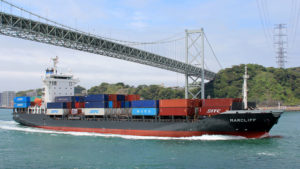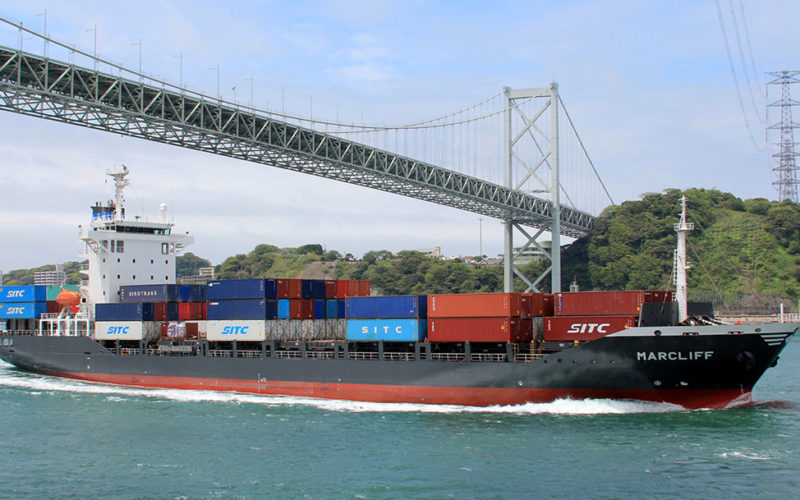
Two containerships collided near Japan’s Port of Yokohama in an incident that highlighted navigational challenges within congested Tokyo Bay.
The U.S.-flagged APL Guam was inbound to an anchorage near the cargo terminals when it hit the outbound Marcliff, which careened into the anchored Hansa Steinburg, the National Transportation Safety Board (NTSB) said in its report.
The incident happened at 2337 on March 21, 2019 in the YL-4 anchorage within the Port of Yokohama. Conditions were clear at the time. No injuries were reported on any of the ships and there was no pollution. Damage to the three vessels reached $1.2 million.
NTSB investigators identified Marcliff’s attempt to thread the needle between APL Guam and Hansa Steinburg as the primary cause of the incident. The agency cited the lack of VHF radio communication between the two ships, something not required under international rules, as a contributing factor.
The NTSB said the port layout increased the risk of accidents like this one. Yokohama Passage, which runs through the port, ends before the main shipping channel. Outbound ships must pass through the anchorage area where the collision happened to reach the channel.
“This arrangement encourages vessel bridge teams to take the most expeditious route through the anchorage, as the Marcliff master did when he turned south-southeast, regardless of the risks of navigating in close proximity to anchored vessels,” the NTSB report said.
The 505-foot APL Guam worked a route between Guam, Saipan and Korea before arriving in Japan. The ship approached Tokyo Bay at about 2200, at which time a local pilot came on board. The master and pilot conducted an exchange of information and the pilot took the conn. Within an hour, the pilot was slowing the ship in preparation for anchoring.
At about the same time, the 468-foot Marcliff got underway from Yokohama’s Terminal BC. The ship’s master was in control, and a third mate and a helmsman carried out his engine and rudder commands. There was no pilot on board, which was not required for ships under 10,000 gross tons.
Deck crew aboard APL Guam continued preparations for anchoring in a location that required the ship to pass between two other anchored vessels. The containership Hansa Steinburg would be off its starboard side, and the tanker Shinsei Maru would be to port. Marcliff intended to pass between the same ships on its outbound voyage into the shipping channel.
Marcliff left Yokohama Passage and turned to starboard in a south-southeast direction. The ship’s master told investigators he intended for a starboard-to-starboard meeting with APL Guam. He believed that arrangement would leave 2 cables of distance (roughly two-tenths of a nautical mile) between APL Guam on one side and Hansa Steinburg on the other. The NTSB later determined that the total distance between Hansa Steinburg and the anchored Shinsei Maru was about 4.5 cables (roughly one-half nautical mile) — wide enough for only one ship to pass between the two while maintaining more than 2 cables separation on either side.
Marcliff’s starboard turn into the anchorage caught the pilot and crew on APL Guam by surprise. The crew blasted the ship’s horn for nearly seven seconds at 2324 to get Marcliff’s attention. Based on Marcliff’s movements, the pilot on APL Guam ordered its rudder hard to starboard and its engine slow ahead to create distance with the oncoming ship.
According to the NTSB, at about 2325 the master aboard APL Guam “expressed bewilderment” at the actions taken by the oncoming ship. APL Guam blasted its horn six times at the pilot’s request, then another 11 times about 30 seconds later. Marcliff’s master appeared to understand the unfolding situation. He turned the ship to port in an effort to skirt between APL Guam and Hansa Steinburg.
“A few seconds later, the Marcliff master yelled an expletive in English before speaking with the third mate in his native language,” the report said. “The Marcliff master told investigators that he had not expected APL Guam to turn to starboard, and he believed that if APL Guam had maintained its original course, the vessels would have passed safely starboard to starboard.”
APL Guam’s master took control of the ship just before 2326. He ordered the engine full astern to slow the ship, which was traveling at 6 knots. Thirty seconds later, he warned the crew via handheld radio of the impending collision. Marcliff’s captain also ordered the engine astern in an effort to reduce the impact.
The ships collided 11 seconds after APL Guam’s master alerted the crew. The ship hit Marcliff on its starboard bow, pushing the vessel to port. Marcliff continued toward Hansa Steinburg at nearly 9 knots, hitting the anchored ship on its starboard bow.
The NTSB focused on actions taken by Marcliff’s master in the minutes leading up to the collision. The agency suggested he might have briefly lost situational awareness during a crucial stage of the voyage. It said his actions were unexpected by the approaching APL Guam.
“Because APL Guam and Marcliff were in a crossing situation and APL Guam was on the starboard side of Marcliff, by international convention, Marcliff was required to keep out of the way of APL Guam and avoid crossing ahead of it,” the NTSB said.
“The master ordered a 10-degree turn to port about one minute before the collision, but Marcliff should have altered course to starboard to avoid crossing ahead of APL Guam,” the report continued. “A turn to starboard would have been predictable by the APL Guam pilot and bridge team and resulted in a port-to-port meeting between the vessels.”
The NTSB affirmed steps taken by APL Guam’s master and pilot to avoid the collision. Specifically, these included the pilot’s hard-to-starboard rudder command, and the master’s decision to take control of the ship and order the engine astern. Both likely reduced the severity of the collision, the report said.
APL, the operator of APL Guam, is based in Maryland. The company is part of the international CMA CGM Group. Marcliff Schiffahrts GmbH owns Marcliff, which flies an Antigua and Barbuda flag and is operated by MarConsult Schiffahrt GmbH & Co. Attempts to reach the firms for comment were not successful.
Casey Conley

